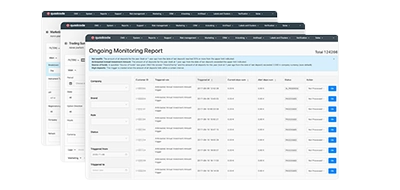กลับ
Contents
Volume Oscillator (VO): คำจำกัดความ ประเภท คุณสมบัติ กลยุทธ์ ข้อดีและข้อเสีย


Demetris Makrides
Senior Business Development Manager

Vitaly Makarenko
Chief Commercial Officer
Volume Oscillator เป็นเครื่องมือทางเทคนิคที่ใช้สำหรับวิเคราะห์ปริมาณการซื้อขาย ตัวบ่งชี้นี้จะกำหนดความแตกต่างระหว่างค่าเฉลี่ยเคลื่อนที่สองค่าของปริมาณการซื้อขาย การแสดงความแตกต่างในรูปแบบกราฟิกช่วยให้เทรดเดอร์สามารถระบุรูปแบบที่บ่งชี้ถึงแรงซื้อและแรงขายในตลาดได้
ประเด็นสำคัญ:
- Volume Oscillator หมายถึงอะไร?
- ออสซิลเลเตอร์ทำงานอย่างไร?
- สูตรใดที่ใช้ในการคำนวณออสซิลเลเตอร์?
- การเปลี่ยนแปลงของ Volume Oscillator
- ผู้ค้าสามารถรวมออสซิลเลเตอร์กับเครื่องมือทางเทคนิคอื่น ๆ ได้อย่างไร
- กลยุทธ์ที่แพร่หลายที่สุดที่รวมถึง Volume Oscillator มีอะไรบ้าง?
- ข้อดีและข้อเสียของ Volume Oscillator
Volume Oscillator คืออะไร?
เป้าหมายหลักของ Volume Oscillator คือการวิเคราะห์ปริมาณการซื้อขายในตลาดและแสดงให้เห็นถึงความสัมพันธ์ระหว่างปริมาณการซื้อขายและการเคลื่อนไหวของราคา ออสซิลเลเตอร์จะวัดความแตกต่างระหว่างค่าเฉลี่ยเคลื่อนที่สองค่า และช่วยให้เทรดเดอร์ได้รับข้อมูลที่สำคัญและแม่นยำเกี่ยวกับการเคลื่อนไหวของตลาด
Volume Oscillator เป็นเครื่องมือวัดแรงกระตุ้นที่ใช้ระบุการเปลี่ยนแปลงของแรงซื้อและแรงขาย ตัวบ่งชี้นี้กำหนดว่าปริมาณการซื้อขายเบี่ยงเบนไปจากค่าเฉลี่ยเคลื่อนที่อย่างไร ข้อมูลที่ได้รับช่วยให้เทรดเดอร์เข้าใจถึงความแข็งแกร่งของแนวโน้มปัจจุบัน หรือหาเงื่อนไขเบื้องต้นสำหรับการกลับตัวของแนวโน้ม
เมื่อวิเคราะห์ข้อมูลจาก Volume Oscillator เทรดเดอร์อาจพิจารณาความแข็งแกร่งของแนวโน้ม หากราคาหุ้นปรับตัวสูงขึ้น แสดงว่าแนวโน้มขาขึ้นกำลังเพิ่มขึ้น ส่วนเส้นแนวโน้มขาลงของอินดิเคเตอร์แสดงถึงแรงกดดันขาลง

ออสซิลเลเตอร์ทำงานอย่างไร?
มาเพิ่มตราสารบนแผนภูมิเพื่อแสดงให้เห็นว่า Volume Oscillator มีลักษณะอย่างไร
เมื่อเราเพิ่มตัวบ่งชี้ลงในแผนภูมิ ตัวบ่งชี้จะแสดงในหน้าต่างแยกต่างหากใต้แผนภูมิหลัก เครื่องมือนี้มีลักษณะเหมือนเส้นที่เคลื่อนตัวขึ้นหรือลงจากระดับ 0%

ค่า Volume Oscillator คำนวณตามสูตร:
Vol Osc = 100 * (EMA สั้น – EMA ยาว) / EMA ยาว
- EMA สั้น – ค่าเฉลี่ยเคลื่อนที่แบบเอ็กซ์โพเนนเชียลที่มีช่วงเวลาที่สั้นกว่าสำหรับปริมาณการซื้อขาย
- EMA แบบยาว – ค่าเฉลี่ยเคลื่อนที่แบบเอ็กซ์โพเนนเชียลที่มีระยะเวลายาวนานกว่าสำหรับปริมาณการซื้อขาย
เมื่อพูดถึงการตั้งค่าเริ่มต้น จะใช้ EMA 5 (ระยะสั้น) และ EMA 10 (ระยะยาว) แต่เทรดเดอร์อาจเปลี่ยนการตั้งค่าและสร้าง Volume Oscillator สำหรับช่วงเวลาอื่นๆ ได้หากจำเป็น นอกจากนี้ คุณยังสามารถเปลี่ยนช่วงเวลาทั้งหมดที่ใช้ในการคำนวณ (ตั้งแต่ 1 ติ๊ก ถึง 12 เดือน)
ด้วยเหตุนี้ เราจึงเข้าใจลักษณะของตัวบ่งชี้ และการตั้งค่าที่เทรดเดอร์อาจเปลี่ยนแปลงเมื่อใช้เครื่องมือนี้ ลองมาเจาะลึกการทำงานของ Volume Oscillator กัน
องค์ประกอบสำคัญของตัวบ่งชี้
Volume Oscillator ประกอบด้วยส่วนประกอบต่อไปนี้:
- ค่าเฉลี่ยเคลื่อนที่แบบเอ็กซ์โพเนนเชียลระยะสั้นและระยะยาว Volume oscillator เปรียบเทียบค่าเฉลี่ยเคลื่อนที่ระยะสั้นกับค่าเฉลี่ยเคลื่อนที่ระยะยาว การเปรียบเทียบนี้จะช่วยปรับข้อมูลให้เรียบและลดสัญญาณรบกวนจากตลาด ซึ่งเป็นเหตุผลที่เทรดเดอร์สามารถระบุแนวโน้มได้ง่ายขึ้น
- ระดับซื้อมากเกินไป (Overbought) และขายมากเกินไป (Oversold) Volume Oscillator และรูปแบบต่างๆ จะแสดงระดับที่สินทรัพย์อยู่ในภาวะซื้อมากเกินไป (Overbought) หรือขายมากเกินไป (Oversold) ระดับเหล่านี้เป็นตัวบ่งชี้ภาวะซื้อและขายที่รุนแรง และช่วยให้เทรดเดอร์คาดการณ์การกลับตัวของแนวโน้มในอนาคตได้ เมื่อเส้นของออสซิลเลเตอร์ไปถึงระดับซื้อมากเกินไป (Overbought) แสดงว่าตลาดพร้อมสำหรับการปรับฐานขาลง และในทางกลับกัน
- ไดเวอร์เจนซ์ ไดเวอร์เจนซ์เกิดขึ้นเมื่อราคาของสินทรัพย์และเส้นออสซิลเลเตอร์เคลื่อนที่ไปในทิศทางตรงกันข้าม สถานการณ์เช่นนี้แสดงให้เห็นว่าแนวโน้มปัจจุบันได้สิ้นสุดลงแล้ว และตลาดพร้อมสำหรับการเคลื่อนไหวกลับตัว ตัวอย่างเช่น ราคาของสินทรัพย์ขยับสูงขึ้น แต่ Volume Oscillator กลับลดลงอย่างต่อเนื่อง แรงซื้อจึงอ่อนลง และถึงเวลาเปิดสถานะขายแล้ว
ความเข้าใจในองค์ประกอบที่กล่าวถึงข้างต้นถือเป็นสิ่งสำคัญอย่างยิ่งสำหรับผู้ซื้อขายที่ต้องการใช้ Volume Oscillator ในกลยุทธ์ของตน
หลักการทำงานของ Volume Oscillator
ตราสารนี้ใช้เส้น EMA สองเส้น และคำนวณความแตกต่างระหว่างค่าเฉลี่ยเคลื่อนที่ ค่าเบี่ยงเบนนี้แสดงถึงการบรรจบ/แยกออกจากกันของปริมาณการซื้อขายในช่วงเวลาหนึ่ง
- เมื่อค่า EMA สั้นสูงกว่าค่า EMA ยาว เส้นของออสซิลเลเตอร์จะเคลื่อนที่ภายใน "บริเวณบวก"
- เมื่อค่า EMA ยาวสูงกว่าค่า EMA สั้น เส้นของออสซิลเลเตอร์จะเคลื่อนที่ภายใน "พื้นที่ลบ"

จะกำหนดค่าการตั้งค่าของ Volume Oscillator ได้อย่างไร?
เมื่อเพิ่มเครื่องมือลงในกราฟ การตั้งค่าส่วนใหญ่จะประกอบด้วยช่วงเวลาต่อไปนี้: 5 สำหรับค่าเฉลี่ยเคลื่อนที่แบบเอ็กซ์โพเนนเชียลระยะสั้น และ 10 สำหรับค่าเฉลี่ยเคลื่อนที่แบบเอ็กซ์โพเนนเชียลระยะยาว เทรดเดอร์มืออาชีพจะเปลี่ยนการตั้งค่าเพื่อลดสัญญาณรบกวนของอินดิเคเตอร์ โดยเปลี่ยนช่วงเวลา EMA ระยะสั้นเป็น 23 และเลือก 50 สำหรับช่วงเวลา EMA ระยะยาว

ในส่วนของสีและการตั้งค่ากราฟิกอื่นๆ คุณสามารถใช้ตัวเลือกใดๆ ก็ได้ที่คุณต้องการ เนื่องจากตัวเลือกเหล่านั้นไม่ส่งผลต่อประสิทธิภาพ
สัญญาณการซื้อขายที่กำหนดโดย Volume Oscillator
เทรดเดอร์มืออาชีพเข้าใจดีว่าตัวบ่งชี้นี้เป็นหนึ่งในเครื่องมือที่มีประสิทธิภาพที่สุด แล้วจะใช้เครื่องมือนี้ในการวิเคราะห์ทางเทคนิคได้อย่างไร? มีรูปแบบบางอย่างที่เทรดเดอร์คำนึงถึง:
- ความแตกต่างระหว่างการเคลื่อนไหวของราคาสินทรัพย์และ Volume Oscillator เมื่อเทรดเดอร์พบสถานการณ์ตลาดเมื่อราคาของสินทรัพย์ขยับสูงขึ้น และเส้นของ Volume Oscillator ขยับต่ำลง บ่งชี้ว่ามีความน่าจะเป็นสูงที่จะเกิดการกลับตัวของแนวโน้ม ตัวอย่างเช่น ราคา Bitcoin จะเพิ่มขึ้นเมื่อ Oscillator แสดงการเคลื่อนไหวในทิศทางตรงกันข้าม เราสรุปได้ว่าแนวโน้มปัจจุบันหมดลงแล้ว และราคาของสกุลเงินดิจิทัลกำลังจะขยับลง

- การบรรจบกันระหว่างการเคลื่อนไหวของราคาสินทรัพย์และ Volume Oscillator เมื่อเทรดเดอร์สังเกตเห็นว่าราคาสินทรัพย์ขยับสูงขึ้น และเส้นของ Volume Oscillator เคลื่อนที่ไปในทิศทางเดียวกัน ตลาดจะมีลักษณะเป็นแนวโน้มขาขึ้นที่ค่อนข้างแข็งแกร่ง ในสถานการณ์เช่นนี้ เทรดเดอร์จะเปิดสถานะตามแนวโน้ม

- ระดับซื้อมากเกินไปและขายมากเกินไป เมื่อเส้นออสซิลเลเตอร์แตะบริเวณซื้อมากเกินไปหรือขายมากเกินไป มีโอกาสสูงที่ราคาจะเคลื่อนไหวในทิศทางตรงกันข้าม เมื่อพูดถึง Volume Oscillator แบบมาตรฐาน บริเวณซื้อมากเกินไปและขายมากเกินไปจะอยู่ที่ระดับสูงกว่า 40% และต่ำกว่า -40%
ตัวแปรของ Volume Oscillator
Volume Oscillator เป็นเครื่องมือพื้นฐานที่ใช้ในการวิเคราะห์ปริมาณการซื้อขาย ในขณะเดียวกัน หมวดหมู่นี้ยังรวมถึงเครื่องมือทางเทคนิคอื่นๆ ที่ใช้หลักการเดียวกันนี้ด้วย Volume Oscillator ใดที่ได้รับความนิยมมากที่สุด
ไชคิน มันนี่ โฟลว์
ตัวบ่งชี้นี้ได้รับการพัฒนาโดย Mark Chaikin โบรกเกอร์และนักวิเคราะห์ชื่อดัง ตามทฤษฎีของเขา เส้นสะสม/การกระจายที่คำนึงถึงทั้งราคาและปริมาณการซื้อขาย จะช่วยเปิดมุมมองเชิงลึกเกี่ยวกับแนวโน้มตลาด
ดัชนี CMF คำนวณจากองค์ประกอบหลักสองประการ ได้แก่ ปริมาณเงินไหลเข้า (Money Flow Volume) และตัวคูณปริมาณเงินไหลเข้า (Money Flow Multiplier) ปริมาณเงินไหลเข้าคำนวณโดยการคูณราคาเฉลี่ยของสินทรัพย์ด้วยปริมาณการซื้อขาย ตัวคูณปริมาณเงินไหลเข้าคำนวณโดยขึ้นอยู่กับว่าราคากำลังขยับขึ้นหรือลง
Chaikin Money Flow มอบสัญญาณต่อไปนี้ให้กับผู้ซื้อขาย:
- หาก CMF เป็นบวกและยังคงเพิ่มขึ้น แสดงว่ายังมีแรงซื้อและแนวโน้มขาขึ้นอาจดำเนินต่อไป
- หาก CMF เป็นลบและยังคงลดลงต่อไป แสดงว่าเกิดแรงขายและแนวโน้มขาลงอาจดำเนินต่อไป
- หาก CMF เคลื่อนไหวอยู่ที่ประมาณศูนย์ ความสมดุลระหว่างผู้ซื้อและผู้ขายจะปรากฏขึ้น และแนวโน้มอาจไม่แน่นอน

ปริมาณสมดุล
ตัวบ่งชี้ปริมาณการซื้อขายแบบสมดุล (On Balance Volume indicator) คำนวณความสัมพันธ์ระหว่างการเปลี่ยนแปลงราคาและการเปลี่ยนแปลงปริมาณการซื้อขาย ตราสารนี้อาศัยทฤษฎีที่ว่า การเคลื่อนไหวราคาอย่างมีนัยสำคัญมักจะมาพร้อมกับการเปลี่ยนแปลงปริมาณการซื้อขายอย่างรวดเร็ว ตัวอย่างเช่น เมื่อผู้เล่นรายใหญ่เริ่มลงทุนในสินทรัพย์อย่างมหาศาล ปริมาณการซื้อขายก็จะเพิ่มขึ้นอย่างรวดเร็ว เมื่อเวลาผ่านไป การเคลื่อนไหวเหล่านี้จะส่งผลกระทบต่อราคาสินทรัพย์ด้วยเช่นกัน
ปริมาณการซื้อขายแบบสมดุล (On Balance Volume) จะแสดงที่ด้านล่างของกราฟ เส้นราคาจะสูงขึ้นเมื่อราคาเพิ่มขึ้น และจะลดลงเมื่อราคาลดลง การกระโดดขึ้นอย่างรวดเร็วของตัวบ่งชี้แสดงถึงการมีส่วนร่วมของผู้เล่นรายใหญ่ และการเพิ่มขึ้นอย่างราบรื่นบ่งชี้ว่าผู้เล่นรายอื่นๆ ได้เข้าร่วมการซื้อขายแล้ว
ลักษณะเด่นของเครื่องดนตรีมีดังนี้:
- คำนวณความสัมพันธ์กันระหว่างการเคลื่อนไหวของราคาและการเคลื่อนไหวของปริมาณ
- แสดงให้เห็นอารมณ์ของผู้เล่นหลัก
- ช่วยคาดการณ์ความเคลื่อนไหวของราคาต่อไป

คลิงเกอร์ ออสซิลเลเตอร์
Klinger Oscillator เป็นอินดิเคเตอร์ทางเทคนิคที่อิงตามปริมาณการซื้อขาย ซึ่งใช้เปรียบเทียบปริมาณการซื้อขายกับราคาเพื่อคาดการณ์การกลับตัวของราคา เครื่องมือนี้เปิดตัวโดย Stephan Klinger ในปี พ.ศ. 2520
ตัวบ่งชี้นี้ประกอบด้วยเส้นสองเส้น แทนค่า KVO และค่าเฉลี่ยเคลื่อนที่แบบเอ็กซ์โพเนนเชียล (EMA) EMA ใช้เพื่อกำหนดค่าเฉลี่ยเคลื่อนที่ 13 ช่วงเวลา และเป็นตัวบ่งชี้หลักสำหรับการซื้อหรือขาย ตัวบ่งชี้นี้แสดงให้เห็นว่าการเคลื่อนไหวของปริมาณการซื้อขายส่งผลต่อระดับราคาอย่างไร
Klinger Oscillator ช่วยระบุสัญญาณซื้อและขายผ่านเส้นค่าเฉลี่ยเคลื่อนที่ 13 ช่วงเวลา ในส่วนนี้ Klinger Oscillator ทำหน้าที่คล้ายกับตัวบ่งชี้ MACD หาก Klinger Oscillator ทะลุเส้นสัญญาณ เทรดเดอร์สามารถเปลี่ยนเป็นสถานะขาขึ้นได้ หาก Oscillator ต่ำกว่าเส้นสัญญาณ แสดงว่ามีแนวโน้มขาลง

ข้อดีและข้อเสียของ Volume Oscillator

ข้อดีหลักของตัวบ่งชี้มีดังนี้:
- ความสามารถในการปรับตัว ตราสารนี้มีประสิทธิภาพในตลาดการเงินและกรอบเวลาที่แตกต่างกัน เทรดเดอร์สามารถใช้ Volume Oscillator สำหรับหุ้น ฟอเร็กซ์ โลหะ คริปโตเคอร์เรนซี และสินทรัพย์อื่นๆ
- ความยืดหยุ่น ผู้ซื้อขายสามารถรวมออสซิลเลเตอร์ปริมาณกับเครื่องมือทางเทคนิคอื่น ๆ ได้อย่างง่ายดายเพื่อรับสัญญาณการซื้อขายที่แม่นยำที่สุดเท่าที่จะเป็นไปได้
- ความแม่นยำ ในกรณีที่มีการกำหนดค่าที่ถูกต้อง Volume Oscillator จะให้สัญญาณการซื้อขายที่แม่นยำแก่ผู้ซื้อขายโดยมีสัญญาณรบกวนจากตลาดน้อยที่สุด
ในส่วนของความเสี่ยงและข้อจำกัดของเครื่องมือนั้นมีการระบุไว้ดังต่อไปนี้:
- เครื่องมือนี้ไม่เหมาะกับสภาพตลาดทุกประเภท
- Volume Oscillator เป็นเรื่องที่ซับซ้อนเกินไปสำหรับเทรดเดอร์มือใหม่
- ตัวบ่งชี้นี้อาศัยคุณภาพของข้อมูลปริมาณ โดยไม่นำข้อมูลราคามาพิจารณา
กลยุทธ์การซื้อขายโดยใช้ Volume Oscillator
ต่อไปนี้เป็นกลยุทธ์การซื้อขายที่แพร่หลายที่สุดที่รวมถึง Volume Oscillator:
- การซื้อขายตามกระแส เมื่อคุณเห็นการบรรจบกันระหว่างออสซิลเลเตอร์และการเคลื่อนไหวของราคา ให้เปิดสถานะตามแนวโน้มตลาดปัจจุบัน ใช้เครื่องมือเพิ่มเติมต่อไปนี้เพื่อรับสัญญาณที่แม่นยำยิ่งขึ้น: ค่าเฉลี่ยเคลื่อนที่, Parabolic SAR ฯลฯ
- การซื้อขายแบบกลับด้าน เปิดสถานะตรงกันข้ามเมื่อสังเกตความแตกต่างระหว่างออสซิลเลเตอร์และการเคลื่อนไหวของราคา หากต้องการรับสัญญาณที่แม่นยำยิ่งขึ้น ให้ใช้เครื่องมือเพิ่มเติมต่อไปนี้: RSI, Stochastic เป็นต้น
- การซื้อขายแบบ Breakout เมื่อราคาสินทรัพย์ทะลุแนวรับหรือแนวต้าน การขยายวอลุ่มของ Volume Oscillator จะเป็นตัวพิสูจน์สัญญาณ นอกจากนี้ คุณยังสามารถใช้อินดิเคเตอร์นี้ร่วมกับ Bollinger Bands, Keltner Channel, Donchian Channel และอื่นๆ ได้
สรุป: Volume Oscillator มีประโยชน์ต่อนักเทรดหรือไม่?
Volume Oscillator จัดอยู่ในประเภทของอินดิเคเตอร์ที่มีประสิทธิภาพและเป็นประโยชน์มากที่สุด แสดงให้เห็นถึงการบรรจบกันและการแยกตัวระหว่างการเคลื่อนไหวของราคาและการเคลื่อนไหวของปริมาณการซื้อขาย ข้อมูลนี้ช่วยให้เทรดเดอร์สามารถระบุแนวโน้มปัจจุบัน ความแข็งแกร่งของแนวโน้ม และการกลับตัวที่อาจเกิดขึ้นได้ นอกจากนี้ Volume Oscillator ยังบ่งชี้ถึงระดับการซื้อมากเกินไปและการขายมากเกินไป ในขณะเดียวกัน เทรดเดอร์มืออาชีพจะไม่พึ่งพาเครื่องมือเหล่านี้แยกกัน กลยุทธ์การซื้อขายที่มีประสิทธิภาพจะรวม Volume Oscillator เข้ากับเครื่องมืออื่นๆ ที่ได้รับความนิยมอย่างกว้างขวาง เพื่อให้ได้รับสัญญาณที่แม่นยำยิ่งขึ้น
อัปเดต:
19 ธันวาคม 2567




